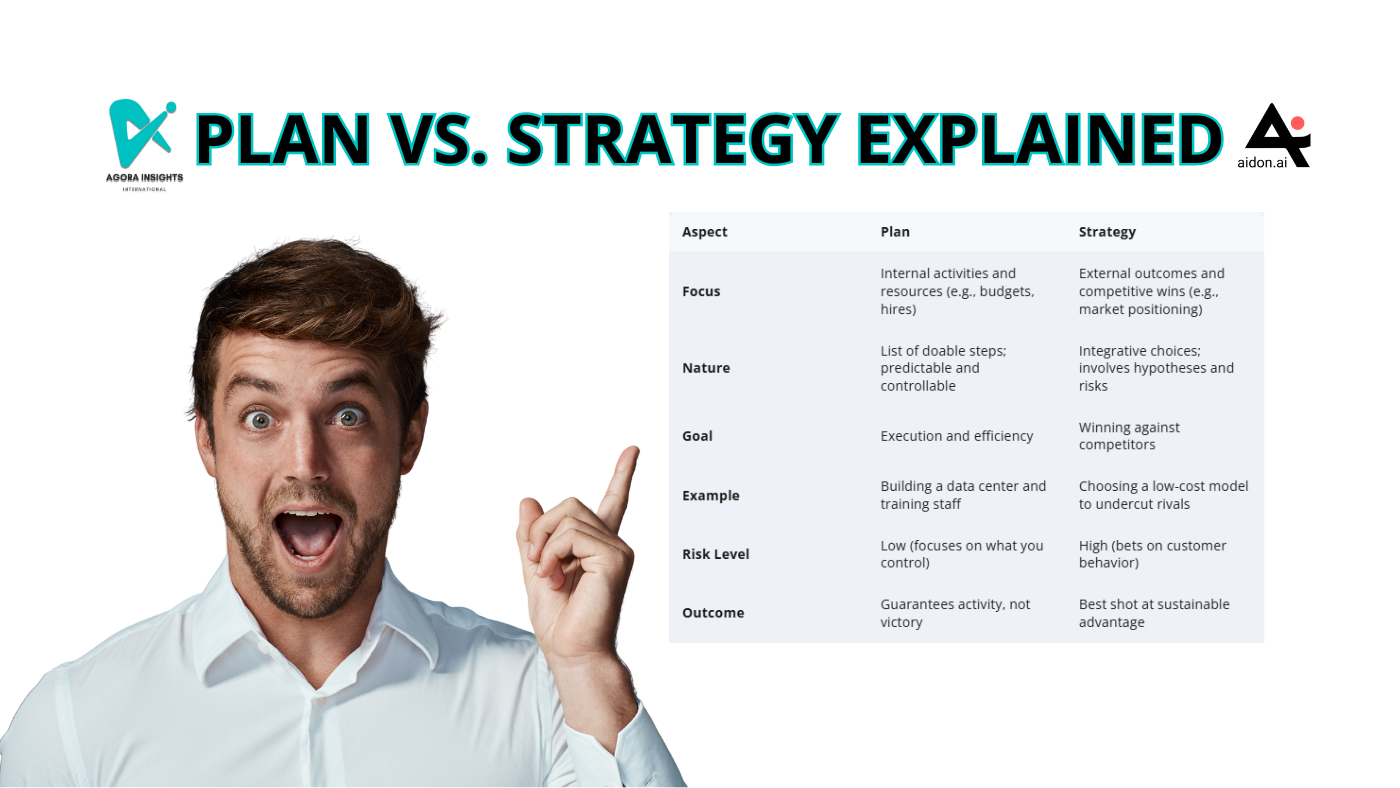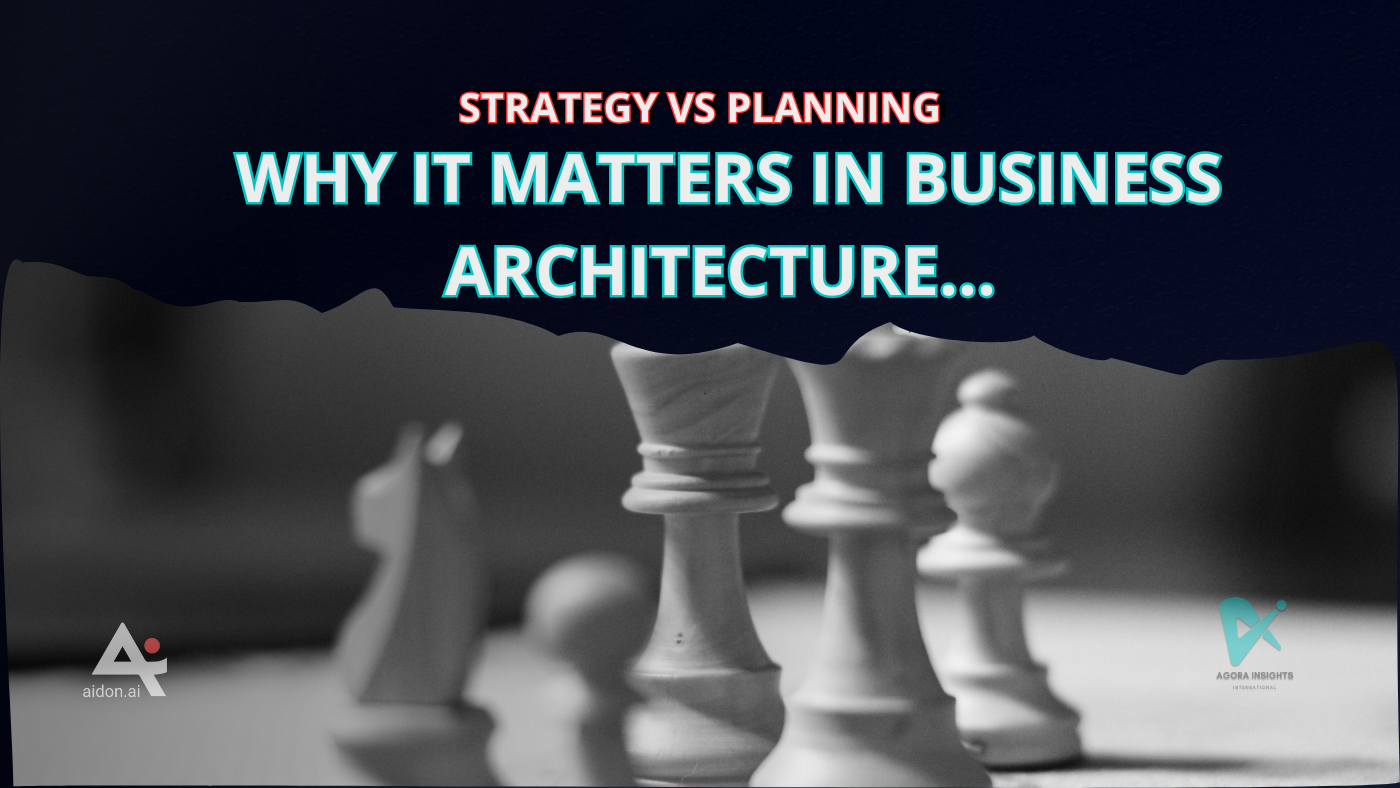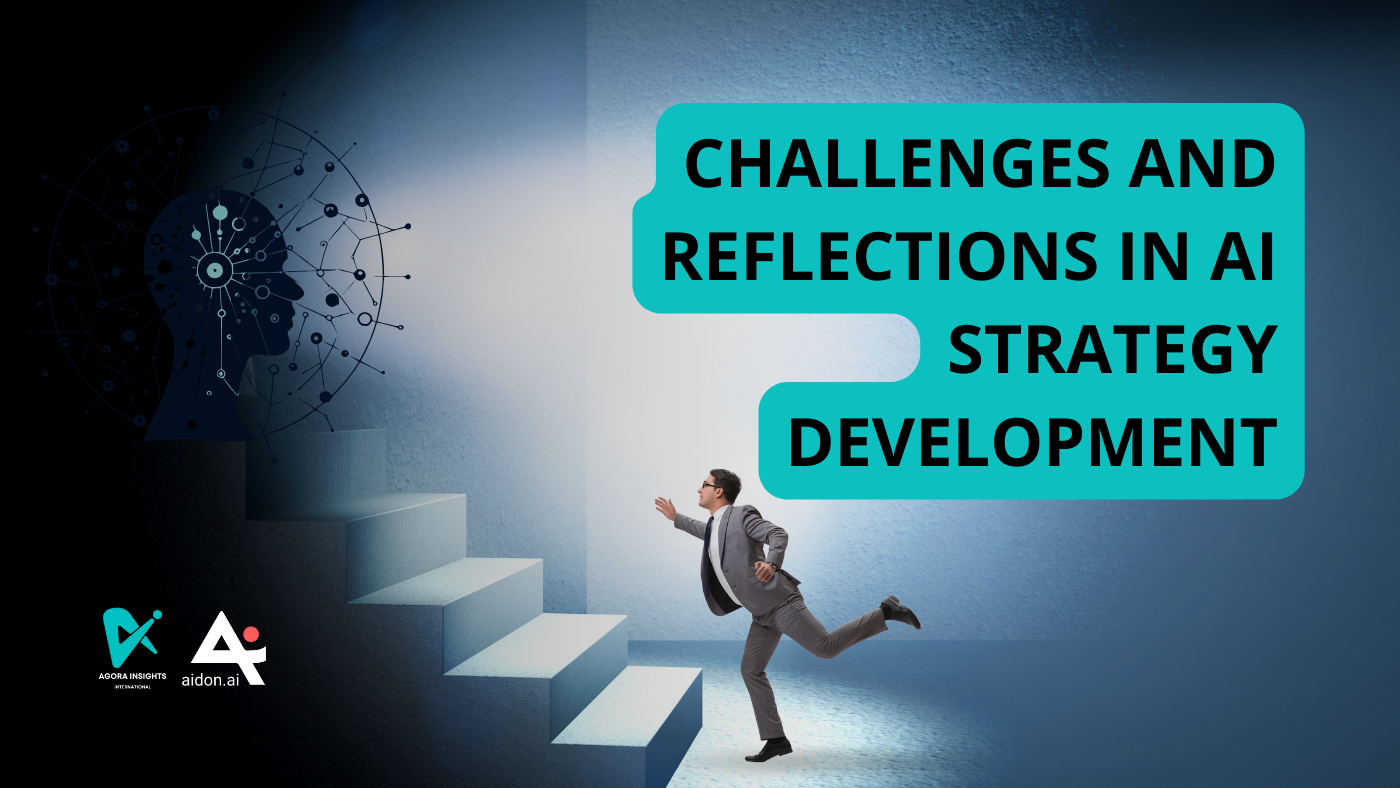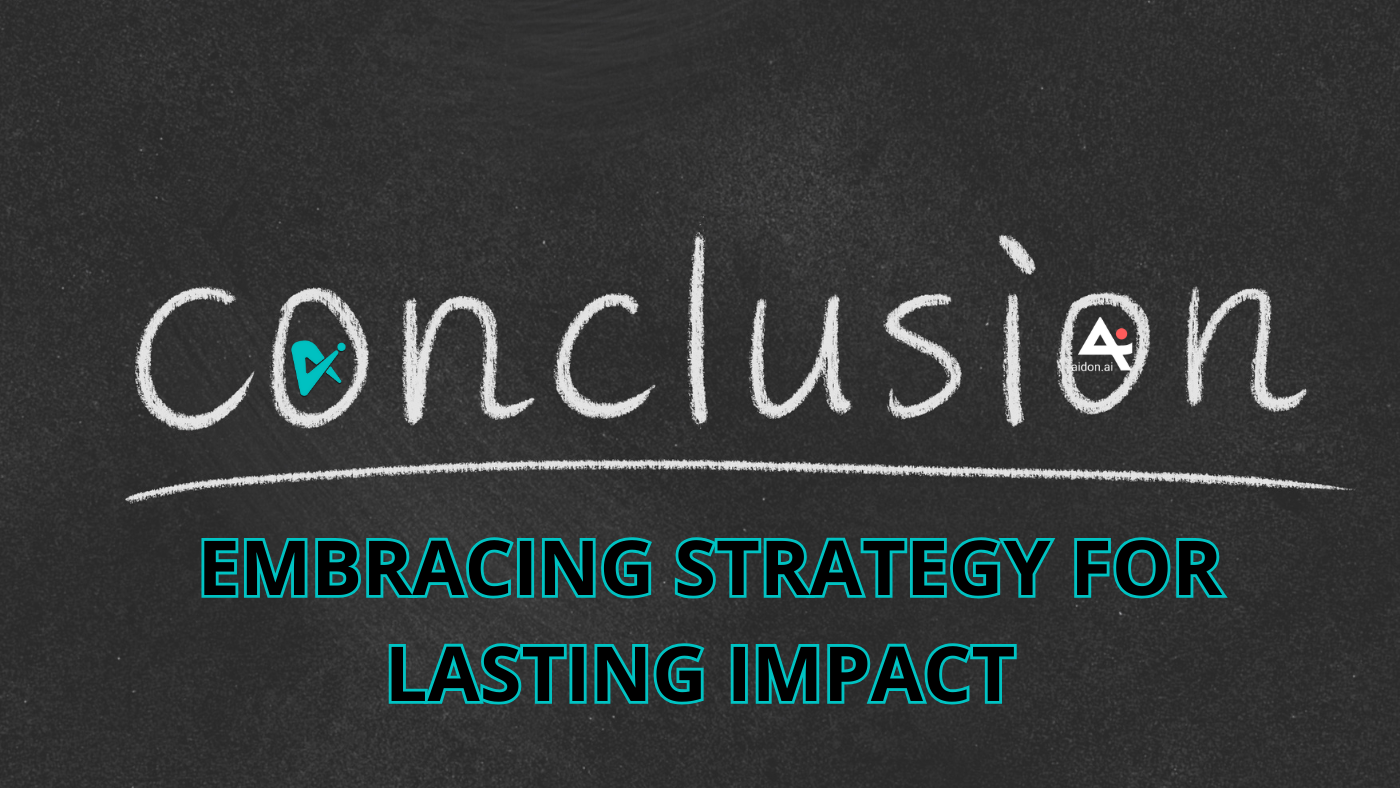Recently, while setting up a chapter in our latest AI training course, I was reminded of a crucial truth: a plan is not a strategy. This distinction is more vital than ever as AI reshapes organizational roles, capabilities, and competitive landscapes. In this post, we'll explore why If you're grappling with "plan vs strategy" in AI contexts, let's get started...
The Fundamental Difference: Plan vs. Strategy Explained
To set the stage, let's break down the essence of each concept, inspired by insights from business thinkers like Roger Martin in sources such as the Harvard Business Review. At its core, a plan is a list of controllable actions—focusing on what you can manage internally, like resources, timelines, and budgets. It's reassuring because it deals with certainties: "We'll do X, Y, and Z."
A strategy, however, is an integrated set of choices that positions your organization to win on a specific playing field. It involves a coherent theory about customers and competitors, embracing risks since outcomes depend on external factors you can't fully control.

| Aspect | Plan | Strategy |
|---|---|---|
| Focus | Internal activities and resources (e.g., budgets, hires) | External outcomes and competitive wins (e.g., market positioning) |
| Nature | List of doable steps; predictable and controllable | Integrative choices; involves hypotheses and risks |
| Goal | Execution and efficiency | Winning against competitors |
| Example | Building a data center and training staff | Choosing a low-cost model to undercut rivals |
| Risk Level | Low (focuses on what you control) | High (bets on customer behavior) |
| Outcome | Guarantees activity, not victory | Best shot at sustainable advantage |
This table underscores why plans feel safe—they're about "playing to participate"—while strategies demand discomfort, hypothesizing why your approach will succeed where others fail. As architects and analysts, we often excel at planning through capability maps and roadmaps, but strategy requires us to link these to a bigger picture: What must be true for this to work? It's a humble reminder that not everything is under our control.
Why This Distinction Matters in Business Architecture
In our field, business architecture is about alignment—connecting vision to capabilities, initiatives, and requirements. But without a strategy underpinning it, our work can just be incremental improvements rather than transformative impact.
A plan might detail enhancing a capability like "customer management," but a strategy asks: How does this help us win customers in a competitive landscape?
Here are some key reasons this matters, in bullet points for clarity:
- Alignment with Uncertainty: Strategies embrace market dynamics, while plans assume predictability—crucial in volatile areas like AI.
- Avoiding Silos: Plans can lead to disconnected efforts; strategies ensure coherence across the organization.
- Facilitating Iteration: Strategies allow for testing assumptions, using tools like knowledge bases to refine approaches.
- Humility in Practice: We must admit that strategies involve bets, not guarantees, encouraging adaptive architectures.
From my observations, teams often call detailed roadmaps "strategic" when they're just comfortable checklists. Strategy requires stepping into the angst of customer-driven outcomes.
Real-World Examples
To illustrate, let's look at industries where this plays out.
Airline Industry: Major carriers planned expansions (e.g., more routes, bigger hubs)—controllable actions that kept them in the game. Southwest's strategy? Target short-haul, low-cost travel as an alternative to buses:
- Standardized on Boeing 737s for efficiency.
- Point-to-point flights, no meals, online bookings.
- Theory: Simplify to offer lower prices, winning price-sensitive customers.
- Outcome: Southwest gained market share; others shared a shrinking pie.
Retail Sector: Walmart didn't just plan store openings; their strategy integrated cost-leadership:
- Leverage scale for supply chain dominance.
- Everyday low prices to attract budget shoppers.
- Theory: Be the cheapest and most accessible, outpacing competitors on efficiency. Smaller chains with growth plans often fail to compete without this coherence.
Disruptive Cases:
- Netflix: Strategized convenient streaming over physical rentals, betting on anytime access.
- Uber: Empowered gig drivers and users via app, disrupting taxis with flexibility.
These examples highlight that plans ensure activity, but strategies create winning theories. In architecture terms, map these to capabilities tied to value propositions.
Applying AI Strategies: Examples and Insights
In AI, where disruption is accelerating, confusing plans with strategies is especially common. Many organizations plan AI adoption (e.g., "Buy tools, train teams") without a theory of victory. For architects and analysts, this means shifting from tactical roadmaps to integrative choices across key dimensions, with a strong emphasis on business architecture capabilities. These capabilities represent the high-level, stable abilities of the organization—what it does to deliver value, such as "Customer Management" (as defined in frameworks like BIZBOK). In an AI context, strategies should align AI initiatives to enhance, automate, or disrupt these capabilities, ensuring they support competitive positioning rather than isolated tech implementations.
Here's five critical dimensions for AI strategiest:
- Capabilities: High-level business abilities enhanced by AI systems to solve problems and deliver value (e.g., "Customer Management" capability, aligning to strategic goals like market expansion).
- Infrastructure: Scalable tech foundations that support capability execution, such as vector databases and data pipelines, enabling secure processing at scale without disrupting core business abilities.
- Talent: Human capital, including architects and analysts, upskilled to map and refine AI-enhanced capabilities (e.g., training teams to integrate AI into capability models for better requirement elicitation).
- Governance: Oversight mechanisms to ensure AI aligns with ethical standards and risk mitigation, protecting capability integrity (e.g., bias checks and performance metrics tied to capability KPIs).
- Tools: Third-party accelerators that speed up capability development and deployment (e.g., chat interfaces or decision dashboards to prototype AI within existing capability maps).
A plan addresses these in isolation; a strategy integrates them with a hypothesis:
"How will this combination enhance our business capabilities to win customers?"
For instance, using capability maps from business architecture, analysts can link AI to root causes in knowledge briefs, ensuring initiatives evolve from current-state capabilities to future-state wins.
Let's examine AI examples...
| AI Context | Plan Example | Strategy Example | Key Theory/Outcome (with BA Capabilities) |
|---|---|---|---|
| E-Commerce | Deploy generative AI for recommendations: Buy tools, set KPIs. | Win via personalization: Integrate AI with unique data for seamless experiences (e.g., Amazon's one-click). | "AI enhances 'Customer Experience Management' capability, using predictive models to boost loyalty; risks include data integration but yield market edge over competitors." |
| Healthcare | Build AI for patient data: Pipelines, models, pilots. | Focus on preventive care: Combine AI with wearables for risk predictions. | "Proactive services automate 'Patient Risk Assessment' capability, winning retention; integrates governance for compliance, linking to 'Data Management' capability." |
| Supply Chain | AI for inventory: Monitoring tools, staff training. | Differentiate efficiency: Real-time predictions to cut stockouts by 30%. | "Agility strengthens 'Supply Chain Optimization' capability; theory bets on AI automating decisions, with talent upskilling architects to map requirements." |
| Logistics | Implement AI agents for automation. | Disrupt with autonomy: Bet on gig-like models for fastest delivery. | "Embrace risks to transform 'Order Management' capability into AI-first; uses tools for rapid prototyping, ensuring coherence across all capabilities for competitive speed." |
In the Supreme Coffee scenario, a plan might involve AI monitoring for stock; a strategy reframes it as enhancing the "Inventory Management" capability for premium service differentiation, like Starbucks' ambiance focus, using AI for predictions and partnerships. Architects here use capability maps to link requirements to strategic goals, ensuring AI disrupts without silos.
Challenges and Reflections in AI Strategy Development
Strategies aren't easy; they require humility. Challenges include:
- Trade-Offs: Prioritize via needs assessments, accepting unprovable outcomes.
- Iteration: Use prototypes and feedback to refine.
- Risk Embrace: AI's pace means betting on disruptions, not avoiding them.
Frameworks help: Align vision to mission, establish governance, identify opportunities, manage data, roadmap with pilots, enable via training, and scale. Start small, like automating reports, then expand.
Conclusion: Embracing Strategy for Lasting Impact
So, a plan is not a strategy—do you know why? Plans provide control, but strategies offer coherent paths to victory amid uncertainty. For business architects and analysts, this means using our tools to support winning theories, especially in AI. Draw from examples like Southwest or Amazon to integrate dimensions and hypothesize outcomes.
This isn't about perfection; strategies evolve. Reflect: Does your AI project have a theory of success?
Happy learning everyone!
To get biweekly videos and interviews from leaders around the world, why don't you try connecting to our Architecting AI for Business Newsletter
Just a reminder that Agora Insights and now Aidon.ai open up a world of learning and AI-Assisted Solutions for Business Architects, Analysts, Strategists, and Business Leaders. Contact us for a demo.
To watch more videos, visit YouTube.
Interested in business architecture and business analysis certification, corporate and AI training?
Go to our website www.agorainsights.com
Connect with Deirdre Caren on LinkedIn
References
- Harvard Business Review - A Plan Is Not a Strategy (by Roger Martin): https://www.youtube.com/watch?v=iuYlGRnC7J8
- Wikipedia - Strategic Planning: https://en.wikipedia.org/wiki/Strategic_planning
- Wikipedia - Business Strategy: https://en.wikipedia.org/wiki/Business_strategy
- Wikipedia - Southwest Airlines: https://en.wikipedia.org/wiki/Southwest_Airlines
- Wikipedia - Walmart*: https://en.wikipedia.org/wiki/Walmart
- Wikipedia - Netflix: https://en.wikipedia.org/wiki/Netflix
- Wikipedia - Uber: https://en.wikipedia.org/wiki/Uber
- Wikipedia - Starbucks: https://en.wikipedia.org/wiki/Starbucks
- Business Architecture Guild - BIZBOK Guide: https://www.businessarchitectureguild.org/page/BIZBOK






Post a Comment